Abstract
Much of the pathology of malaria may be due to the interactions of cytokines, especially tumour necrosis factor (TNF), with various cell types, including endothelial cells, with consequent widespread systemic effects. It has been shown previously that heat-stable exoantigens in the supernatants of blood-stage parasite cultures induced the release of TNF in vitro from activated macrophages and behaved like toxins in vivo, that mice immunized with the antigens are protected from the toxic effect and that their serum specifically blocks the ability of the antigens to stimulate the production of TNF. It is reported here that the inhibitory antibody is mainly IgM and that it appears to be T-independent, as the titres of antisera from T-deficient and immunologically intact mice were similar. Antisera raised against exoantigens from two species of rodent parasite inhibited TNF production by those of the human parasite Plasmodium falciparum, and vice versa, indicating that the TNF-inducing moieties of the exoantigens cross-react and therefore presumably contain common epitopes. Thus vaccination with these exoantigens might provide a means of protection against the clinical effects of malaria and of generating anti-disease immunity by reducing cytokine production. However, these findings imply that it will be necessary to confer on these antigens the ability to stimulate T cells and generate memory before they can provide a useful basis for an anti-disease vaccine. The results obtained are discussed in relation to some of the epidemiological features of malaria.
Full text
PDF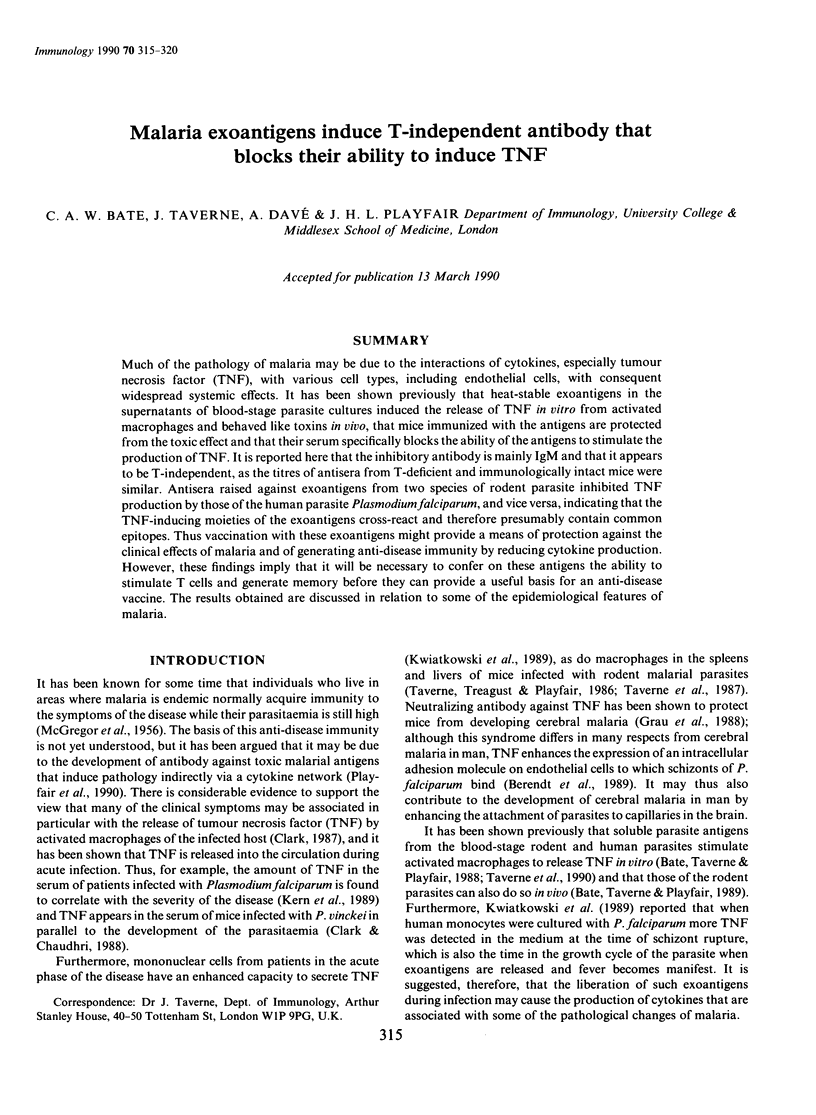
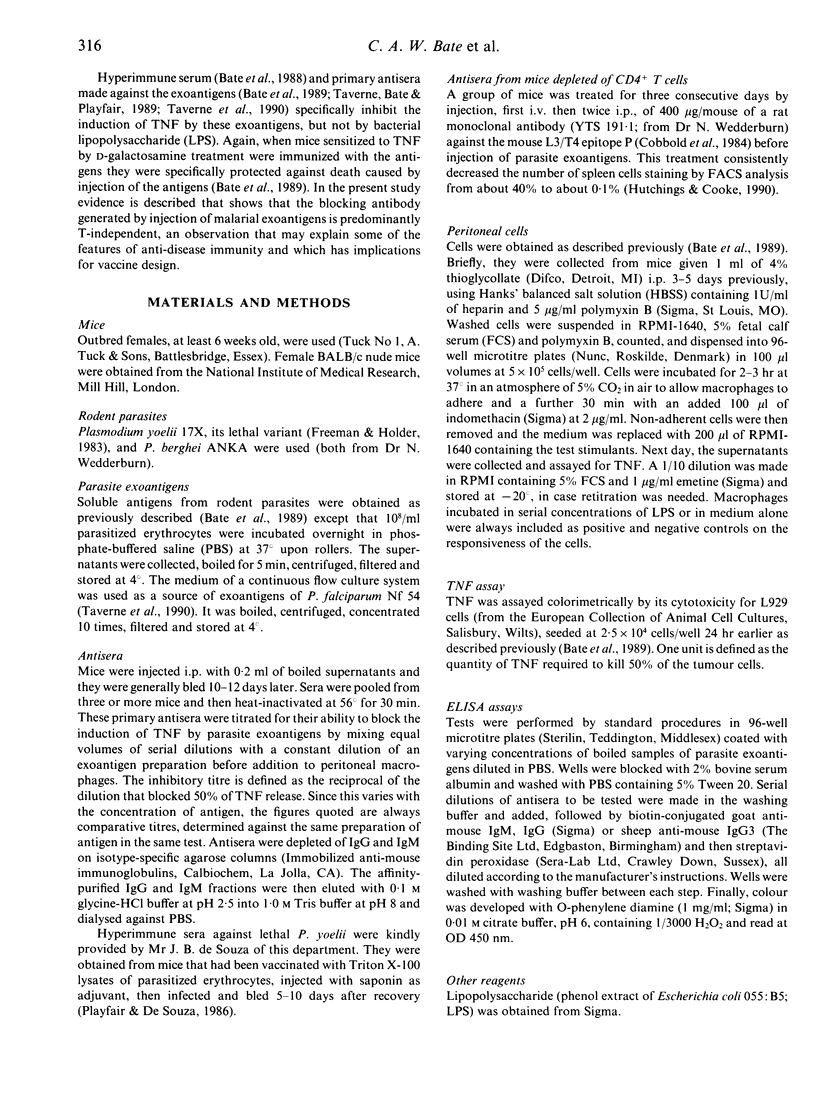
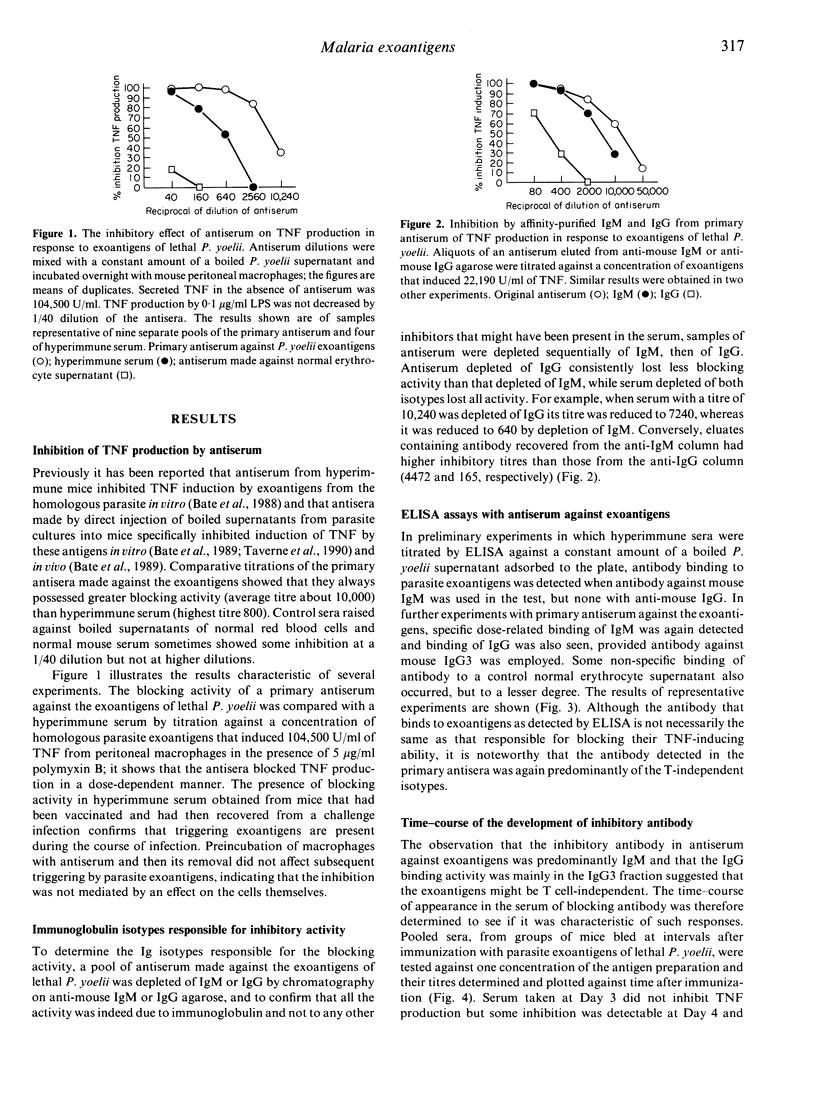
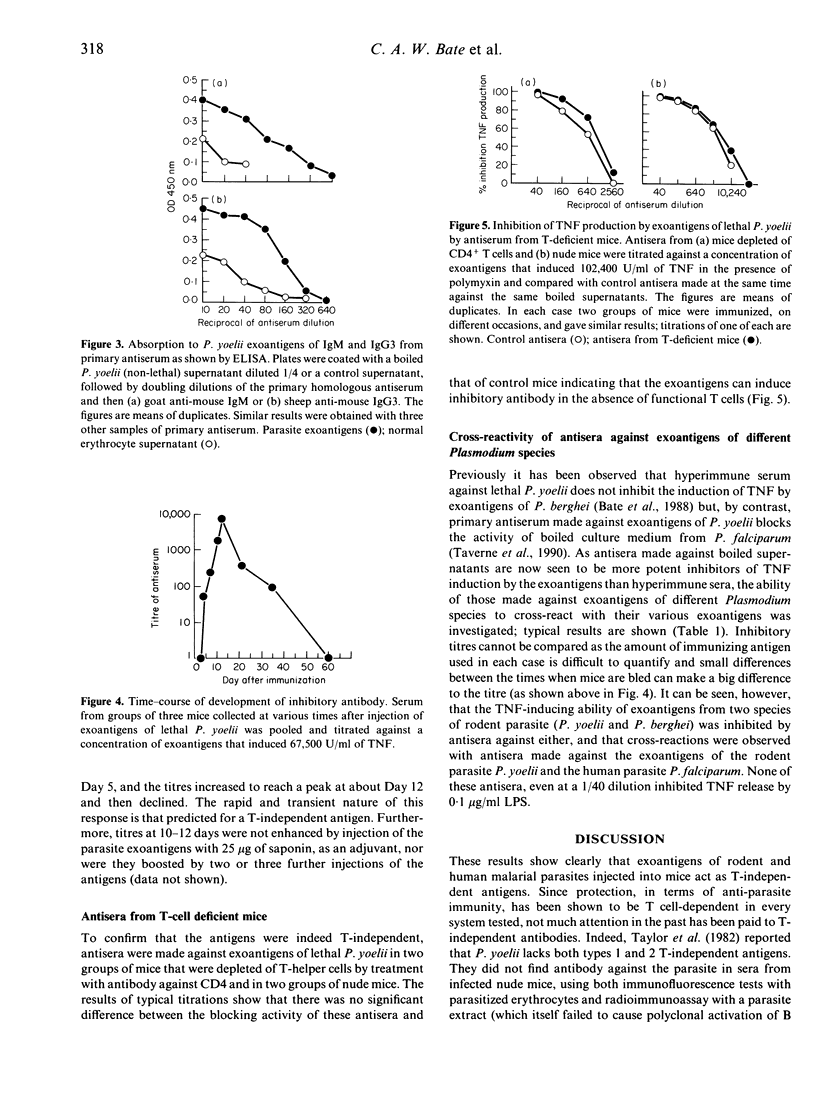
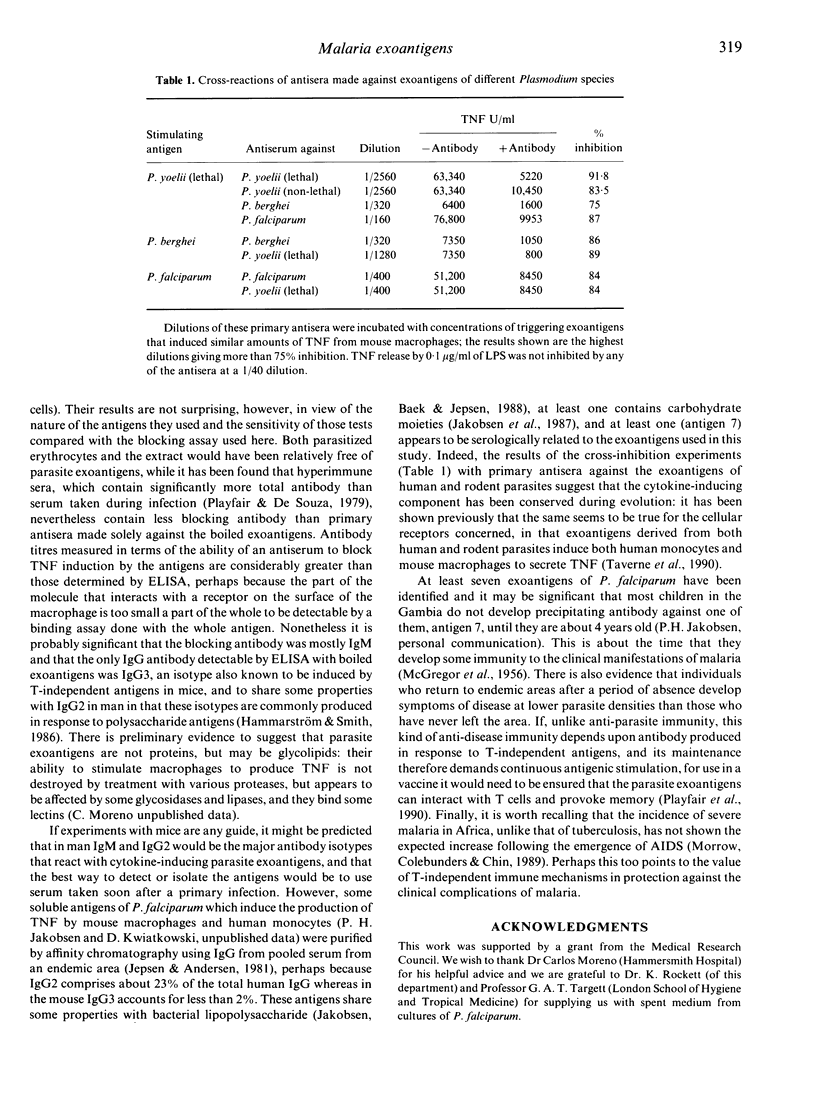
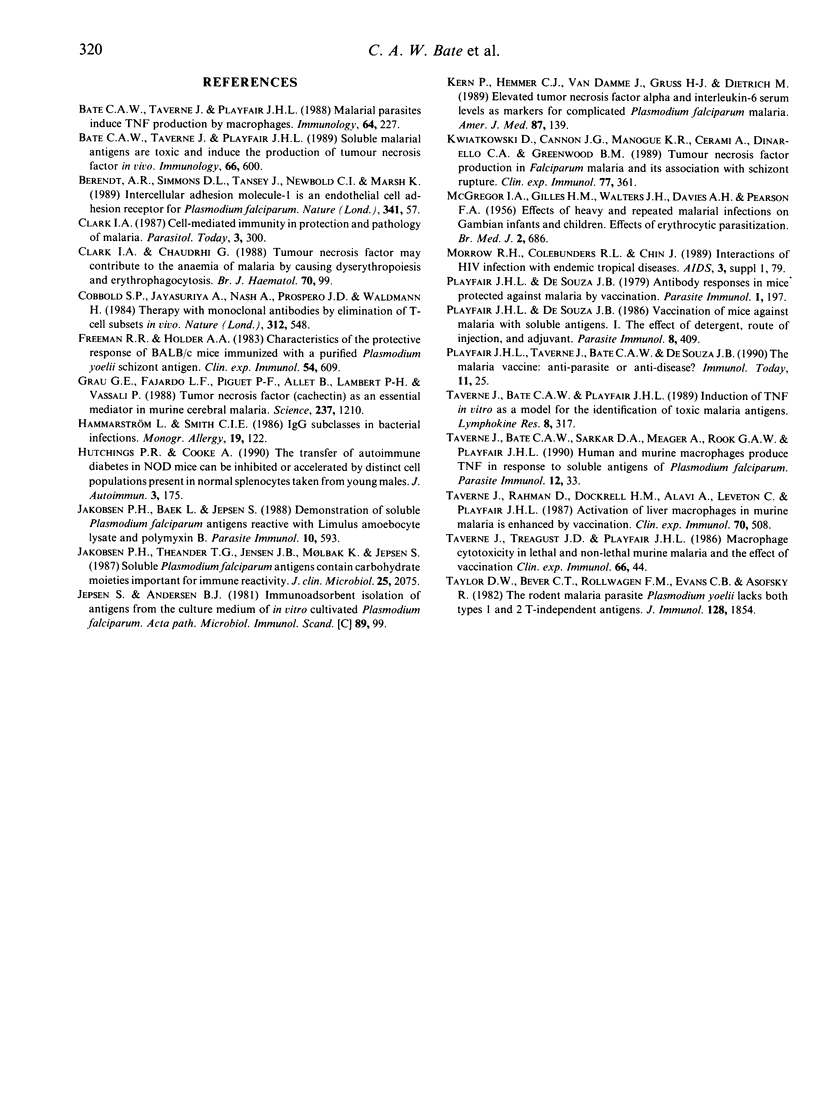
Selected References
These references are in PubMed. This may not be the complete list of references from this article.
- Bate C. A., Taverne J., Playfair J. H. Malarial parasites induce TNF production by macrophages. Immunology. 1988 Jun;64(2):227–231. [PMC free article] [PubMed] [Google Scholar]
- Bate C. A., Taverne J., Playfair J. H. Soluble malarial antigens are toxic and induce the production of tumour necrosis factor in vivo. Immunology. 1989 Apr;66(4):600–605. [PMC free article] [PubMed] [Google Scholar]
- Clark I. A. Cell-mediated immunity in protection and pathology of malaria. Parasitol Today. 1987 Oct;3(10):300–305. doi: 10.1016/0169-4758(87)90187-6. [DOI] [PubMed] [Google Scholar]
- Clark I. A., Chaudhri G. Tumour necrosis factor may contribute to the anaemia of malaria by causing dyserythropoiesis and erythrophagocytosis. Br J Haematol. 1988 Sep;70(1):99–103. doi: 10.1111/j.1365-2141.1988.tb02440.x. [DOI] [PubMed] [Google Scholar]
- Cobbold S. P., Jayasuriya A., Nash A., Prospero T. D., Waldmann H. Therapy with monoclonal antibodies by elimination of T-cell subsets in vivo. Nature. 1984 Dec 6;312(5994):548–551. doi: 10.1038/312548a0. [DOI] [PubMed] [Google Scholar]
- Freeman R. R., Holder A. A. Characteristics of the protective response of BALB/c mice immunized with a purified Plasmodium yoelii schizont antigen. Clin Exp Immunol. 1983 Dec;54(3):609–616. [PMC free article] [PubMed] [Google Scholar]
- Grau G. E., Fajardo L. F., Piguet P. F., Allet B., Lambert P. H., Vassalli P. Tumor necrosis factor (cachectin) as an essential mediator in murine cerebral malaria. Science. 1987 Sep 4;237(4819):1210–1212. doi: 10.1126/science.3306918. [DOI] [PubMed] [Google Scholar]
- Hammarström L., Smith C. I. IgG subclasses in bacterial infections. Monogr Allergy. 1986;19:122–133. [PubMed] [Google Scholar]
- Hutchings P. R., Cooke A. The transfer of autoimmune diabetes in NOD mice can be inhibited or accelerated by distinct cell populations present in normal splenocytes taken from young males. J Autoimmun. 1990 Apr;3(2):175–185. doi: 10.1016/0896-8411(90)90139-j. [DOI] [PubMed] [Google Scholar]
- Jakobsen P. H., Baek L., Jepsen S. Demonstration of soluble Plasmodium falciparum antigens reactive with Limulus amoebocyte lysate and polymyxin B. Parasite Immunol. 1988 Nov;10(6):593–606. doi: 10.1111/j.1365-3024.1988.tb00247.x. [DOI] [PubMed] [Google Scholar]
- Jakobsen P. H., Theander T. G., Jensen J. B., Mølbak K., Jepsen S. Soluble Plasmodium falciparum antigens contain carbohydrate moieties important for immune reactivity. J Clin Microbiol. 1987 Nov;25(11):2075–2079. doi: 10.1128/jcm.25.11.2075-2079.1987. [DOI] [PMC free article] [PubMed] [Google Scholar]
- Kern P., Hemmer C. J., Van Damme J., Gruss H. J., Dietrich M. Elevated tumor necrosis factor alpha and interleukin-6 serum levels as markers for complicated Plasmodium falciparum malaria. Am J Med. 1989 Aug;87(2):139–143. doi: 10.1016/s0002-9343(89)80688-6. [DOI] [PubMed] [Google Scholar]
- Kwiatkowski D., Cannon J. G., Manogue K. R., Cerami A., Dinarello C. A., Greenwood B. M. Tumour necrosis factor production in Falciparum malaria and its association with schizont rupture. Clin Exp Immunol. 1989 Sep;77(3):361–366. [PMC free article] [PubMed] [Google Scholar]
- MCGREGOR I. A., GILLES H. M., WALTERS J. H., DAVIES A. H., PEARSON F. A. Effects of heavy and repeated malarial infections on Gambian infants and children; effects of erythrocytic parasitization. Br Med J. 1956 Sep 22;2(4994):686–692. doi: 10.1136/bmj.2.4994.686. [DOI] [PMC free article] [PubMed] [Google Scholar]
- Playfair J. H., De Souza J. B. Antibody responses in mice protected against malaria by vaccination. Parasite Immunol. 1979 Autumn;1(3):197–208. doi: 10.1111/j.1365-3024.1979.tb00706.x. [DOI] [PubMed] [Google Scholar]
- Playfair J. H., De Souza J. B. Vaccination of mice against malaria with soluble antigens. I. The effect of detergent, route of injection, and adjuvant. Parasite Immunol. 1986 Sep;8(5):409–414. doi: 10.1111/j.1365-3024.1986.tb00857.x. [DOI] [PubMed] [Google Scholar]
- Taverne J., Bate C. A., Playfair J. H. Induction of TNF in vitro as a model for the identification of toxic malaria antigens. Lymphokine Res. 1989 Fall;8(3):317–322. [PubMed] [Google Scholar]
- Taverne J., Bate C. A., Sarkar D. A., Meager A., Rook G. A., Playfair J. H. Human and murine macrophages produce TNF in response to soluble antigens of Plasmodium falciparum. Parasite Immunol. 1990 Jan;12(1):33–43. doi: 10.1111/j.1365-3024.1990.tb00934.x. [DOI] [PubMed] [Google Scholar]
- Taverne J., Rahman D., Dockrell H. M., Alavi A., Leveton C., Playfair J. H. Activation of liver macrophages in murine malaria is enhanced by vaccination. Clin Exp Immunol. 1987 Dec;70(3):508–514. [PMC free article] [PubMed] [Google Scholar]
- Taverne J., Treagust J. D., Playfair J. H. Macrophage cytotoxicity in lethal and non-lethal murine malaria and the effect of vaccination. Clin Exp Immunol. 1986 Oct;66(1):44–51. [PMC free article] [PubMed] [Google Scholar]
- Taylor D. W., Bever C. T., Rollwagen F. M., Evans C. B., Asofsky R. The rodent malaria parasite Plasmodium yoelii lacks both types 1 and 2 T-independent antigens. J Immunol. 1982 Apr;128(4):1854–1859. [PubMed] [Google Scholar]


